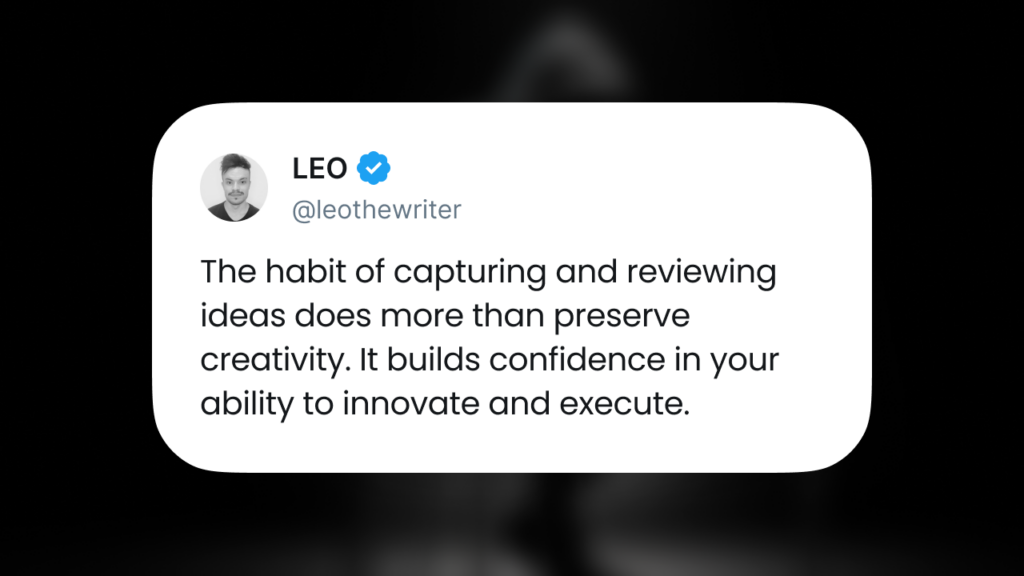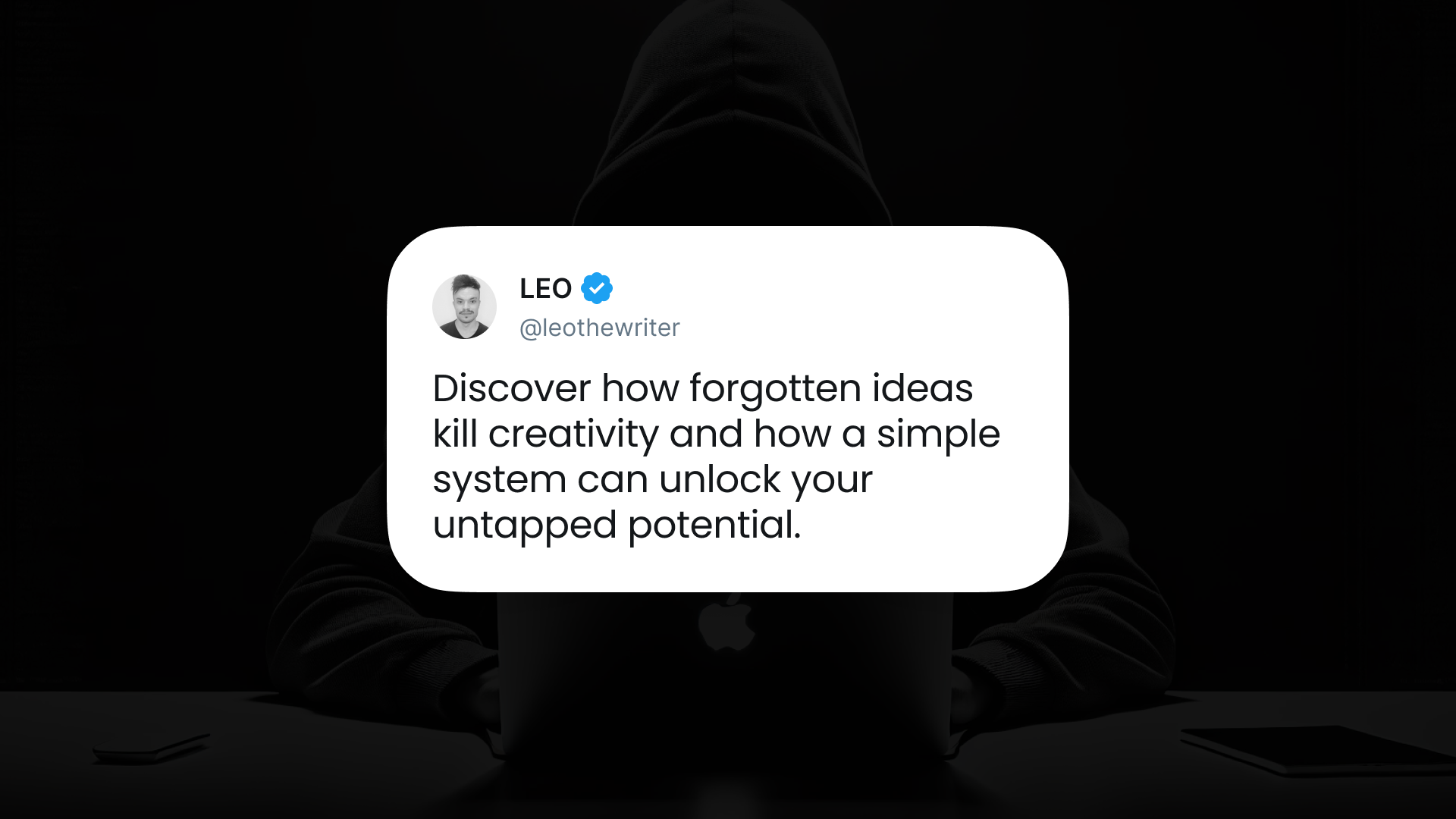You’ve had a brilliant idea before.
Maybe it came to you in the middle of a walk, while you were in the shower, or just before falling asleep.
It felt exciting, original, and full of potential.
You told yourself, I’ll remember this.
But then life distracted you.
A notification, a conversation, or the next thing on your to-do list pulled you away.
By the time you returned to the thought, it was gone. Completely vanished.
This is how creativity fades.
The frustrating part?
It happens to almost everyone.
Research shows that over 90% of creative ideas are forgotten if they are not captured within the first five minutes.
Those fleeting sparks, the ideas that could lead to breakthroughs, slip away, often never to return.
What if your best ideas aren’t lost because you lack creativity, but because you lack a way to hold onto them?
Let me share a quick story.
A few years ago, I felt stuck in a creative rut. I believed I wasn’t coming up with any good ideas, which led to self-doubt and procrastination.
One day, while flipping through an old notebook, I found an idea I had jotted down months earlier. It was simple but brilliant. That idea had the potential to elevate everything I was working on at the time.
That idea had almost disappeared forever. And it wasn’t the first time.
The truth is, creativity doesn’t fail us. We fail creativity.
When inspiration strikes, it comes quickly and unpredictably. If you don’t have a way to capture it, you will always feel stuck, chasing thoughts that slipped away.
You don’t need to be more creative. You need to stop losing the ideas you already have.
In this newsletter, we’ll explore why this happens, what it costs you, and how to implement the Spark-Capture Framework to ensure your best ideas never slip away again.

Why You’re Not as Creative as You Think
Most people believe creativity is a gift, something only a select few are born with.
This belief leads to frustration and self-doubt when ideas don’t seem to come.
The truth is, creativity is a skill, and like any skill, it can be improved with the right approach.
The problem isn’t that you lack creativity. The problem is how you treat it.
Our brains are designed to focus on what feels urgent.
When an idea strikes, it competes with distractions like emails, notifications, and endless tasks. Unless that idea is captured, it fades, often forever.
Here’s what happens.
Ideas live in your short-term memory, which is like a chalkboard. It holds information temporarily, but unless the information is transferred somewhere permanent, it’s erased to make room for other thoughts.
That’s why you can have a brilliant idea one moment and forget it the next.
The long-term effects of ignoring your ideas are even more damaging.
Every time you neglect an idea, you weaken your creative confidence. Over time, you might start to believe you’re not creative at all.
Here’s the shift you need.
Creativity isn’t about waiting for the perfect idea to strike. It’s about building a system to retain and develop those ideas when they come.
As Linus Pauling said, “The best way to have a good idea is to have a lot of ideas.”
If you want to feel more creative, don’t rely on memory. Rely on systems.
The Spark-Capture Framework will help you take those fleeting moments of inspiration and turn them into something tangible.
The question isn’t whether you’re creative. The question is whether you’re ready to preserve your ideas before they disappear.

The Spark-Capture Framework – A System for Creativity
Most people lose their best ideas not because they aren’t creative but because they don’t have a method to preserve and develop them.
The Spark-Capture Framework changes that. It provides a clear process to retain your creativity and turn those fleeting thoughts into tangible outcomes.
Let’s dive deeper into each step of the framework to understand how it can unlock your potential.
Step 1: Notice the Spark
Every creative idea starts with a spark.
These sparks are often subtle, small flashes of inspiration that arise during mundane moments like walking, cooking, or daydreaming.
The challenge is that most people overlook these sparks because they seem too random or insignificant at the moment.
Recognizing sparks requires mindfulness.
Start paying attention to moments of curiosity, surprise, or excitement. These feelings are often signals that your brain has made an unexpected connection or identified something worth exploring.
Developing this awareness takes practice.
Create daily habits that encourage mindfulness, such as setting aside quiet time for reflection or removing unnecessary distractions during routine tasks.
For example, during a morning walk, consciously notice your thoughts and let your mind wander freely. This habit will help you become more attuned to the sparks of creativity that arise naturally.
The key is to train yourself to notice these moments instead of brushing them off.
Curiosity is the starting point of all creativity.
By learning to recognize and value it, you can unlock a steady flow of ideas.
Step 2: Immediate Capture
The next step is to act quickly.
Once you notice a spark, it’s essential to capture it immediately.
The biggest mistake most people make is assuming they will remember an idea later. This assumption is almost always wrong.
Research shows that over 90% of creative ideas are forgotten within minutes
if not written down. Memory is unreliable, especially for fleeting thoughts. To prevent losing your best ideas, you need a reliable capture method.
Your capture method should fit seamlessly into your daily life.
Some people prefer carrying a small notebook for jotting down ideas. Others use notes app like Kortex or Notion, or voice memos.
The specific tool doesn’t matter as much as consistency.
The goal is to make capturing ideas as effortless as possible.
When capturing a spark, don’t worry about being perfect.
A simple sentence or keyword is often enough to preserve the thought.
The act of capturing is what matters most.
By doing this consistently, you reinforce the habit of valuing your ideas and acting on them.
Step 3: Daily Review
Capturing ideas is just the beginning.
The real value of the Spark-Capture Framework lies in the review process.
This is where you transform raw sparks into meaningful insights and actionable plans.
Spend 5 to 10 minutes each day reviewing your captured ideas.
This habit keeps your creativity active and prevents your notes from becoming cluttered or forgotten.
As you review, categorize your ideas into three groups: immediate actions, long-term exploration, and archived thoughts.
Immediate actions are ideas you can implement right away, such as new content, projects, or solutions to current challenges.
Long-term exploration includes ideas that need further development or research.
Archived thoughts are those that may not seem relevant now but could spark future inspiration.
Reviewing your notes also helps you identify patterns.
Over time, you’ll notice recurring themes or connections between ideas.
This process trains your mind to think more creatively by linking disparate thoughts and expanding on them.
One of the most powerful benefits of daily review is clarity.
As Robert Cecil Day-Lewis said, “I don’t write to be understood; I write to understand.”
Reviewing your ideas allows you to deepen your understanding of your own thought process and refine your creative direction.
Step 4: Apply or Discard
Not every idea will become a masterpiece, and that’s okay.
The final step in the Spark-Capture Framework is deciding what to do with the ideas you’ve captured.
This step is about taking action and letting go of what doesn’t serve you.
Start by focusing on the most promising ideas.
These are the ones that feel exciting or relevant to your current goals. Test them in small ways.
For example, if you’re a writer, turn an idea into a tweet. If you’re working on a larger project, use the idea as a starting point to brainstorm further.
For ideas that aren’t immediately actionable, create an archive.
This could be a folder or a tag in your note taking app, or even a simple list.
Archiving ensures that these ideas remain accessible without overwhelming your focus.
The act of applying or discarding ideas is not just a filter for what’s useful. It’s a way to train your creative intuition.
Over time, you’ll become better at recognizing which sparks are worth pursuing and which are best left for later.
When you consistently use the Spark-Capture Framework, it doesn’t just help you preserve ideas. It transforms the way you think.
The habit of noticing, capturing, reviewing, and applying ideas creates a feedback loop that strengthens your creativity over time.
By creating a system for your ideas, you take control of your creativity instead of leaving it to chance. You move from feeling scattered and reactive to feeling clear and intentional.

Building a Sustainable Idea Capture Habit
Ideas are fleeting, and without a consistent system, even the best ones fade away.
The Spark-Capture Framework thrives on consistent practice, and the key to making it work long-term is simplicity.
The goal isn’t to overwhelm yourself but to integrate creativity into your life in a way that feels natural, productive, and rewarding.
Start Small with One Idea a Day
Building a habit begins with small, achievable steps.
Commit to capturing one idea a day.
Whether it’s a passing thought, an observation, or a potential project, write it down. The simplicity of this goal ensures you avoid overthinking the process.
By starting with just one idea, you create momentum. As you build the habit, you’ll notice yourself capturing multiple ideas daily without even thinking about it.
Make It Part of Your Routine
Habits stick when they are tied to something you already do.
Link your idea capture to daily routines.
For example, write down an idea during your morning coffee, after a workout, or right before bed.
These moments are natural pauses in your day, making them ideal for reflection.
Over time, this integration ensures that capturing ideas becomes as natural as brushing your teeth.
Embrace Imperfection
Perfectionism is the enemy of progress.
When capturing ideas, don’t worry about writing full paragraphs or creating detailed plans.
A single sentence or even a few keywords are enough to preserve the thought.
The goal is to lower the barrier to entry.
By making the process easy and quick, you’ll eliminate excuses and build consistency.
Reflect and Refine
At the end of each day, take five minutes to review the idea you captured.
Ask yourself:
- Is this idea actionable?
- Does it align with my goals or current projects?
- How could this idea evolve with more thought?
This daily review reinforces the importance of your creativity and helps you see patterns over time. It also creates a natural opportunity to refine your process and improve how you capture and organize your thoughts.
The habit of capturing and reviewing ideas does more than preserve creativity. It builds confidence in your ability to innovate and execute.
Over time, you’ll notice a shift in how you approach problems, connect dots, and think critically about opportunities.
The Spark-Capture Framework isn’t just a tool. It’s a mindset that turns random sparks of creativity into a constant flow of inspiration.
With this approach, you’ll never lose your best ideas again, and you’ll create the foundation for lifelong growth and clarity.
Thank you for reading.
— Leo.

